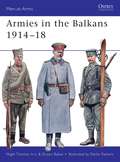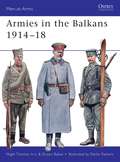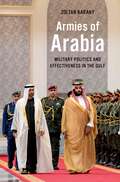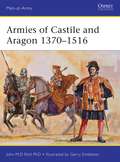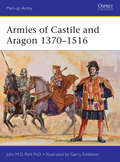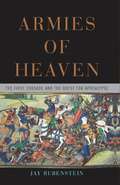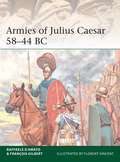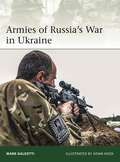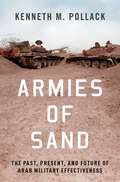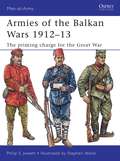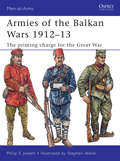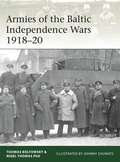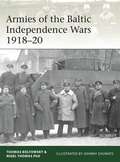- Table View
- List View
Armies in the Balkans 1914–18 (Men-at-Arms)
by Nigel Thomas Darko Pavlovic Dusan BabacRecent history should remind us that it was events in the Balkans which sparked off the Great War, with the assassination of the Austrian heir Prince Franz Ferdinand in Sarajevo, and the consequent invasion of Serbia by Austro-Hungarian armies on 2 August 1914. Nevertheless, the subsequent four-year war in that theatre is always overshadowed by the simultaneous campaigns on the Western Front. For the first time this book offers a concise account of these complex campaigns, the organisation, orders of battle, and the uniforms and insignia of the armies involved: Austro-Hungarian, German, Ottoman, Serbian, Montenegrin, Albanian, British, French, Italian, Russian, Bulgarian, Greek and Rumanian.
Armies in the Balkans 1914–18 (Men-at-Arms #356)
by Nigel Thomas Darko Pavlovic Dusan BabacRecent history should remind us that it was events in the Balkans which sparked off the Great War, with the assassination of the Austrian heir Prince Franz Ferdinand in Sarajevo, and the consequent invasion of Serbia by Austro-Hungarian armies on 2 August 1914. Nevertheless, the subsequent four-year war in that theatre is always overshadowed by the simultaneous campaigns on the Western Front. For the first time this book offers a concise account of these complex campaigns, the organisation, orders of battle, and the uniforms and insignia of the armies involved: Austro-Hungarian, German, Ottoman, Serbian, Montenegrin, Albanian, British, French, Italian, Russian, Bulgarian, Greek and Rumanian.
Armies of Arabia: Military Politics and Effectiveness in the Gulf
by Zoltan BaranyArmies of Arabia is the first comprehensive analysis of the Gulf monarchies' armed forces, including their political, social, and economic characteristics, foreign relations, and battleground performance. The Arabian Peninsula is among the most strategically and economically important areas in the world, but its militaries remain terra incognita. In Armies of Arabia - the first book to comprehensively analyze the Gulf monarchies' armed forces - Zoltan Barany explains their notorious ineffectiveness with a combination of political-structural and sociocultural factors. Drawing on over 150 interviews and meticulous multidisciplinary research, Barany paints a fascinating portrait of Arabia's armies from Ibn Saud's Ikhwan to the present. He explores the methods ruling families employ to ensure their armies' loyalty, examines the backgrounds and career trajectories of soldiers and officers, and explains the monarchies' reliance on mercenaries and the enduring importance of tribal networks. Even though no other world region spends more on security, Arabia's armies remain ineffective because of an absence of meritocracy, the domination of personal connections over institutional norms, insipid leadership, a casual work ethic, and training that lacks intensity, frequency, and up-to-date scenarios. Massive weapons acquisitions are primarily pay-offs to the US for protecting them and have resulted in bloated and inappropriate arsenals and large-scale corruption. Barany explains why the Gulf Cooperation Council has been a squandered opportunity and examines the kingdoms' military relationships with the Arab world and beyond. The performance of the Saudi-led coalition's disastrous war in Yemen starkly illustrates the Gulf armies' humiliating combat record. The book concludes with thoughts on waste (of human potential, resources, institutions) as a dominant theme of Gulf military affairs, considers likely changes in response to long-term weakening demand for oil, and suggests ways in which the armies' effectiveness could be raised. Chock-full of insights and stories from the field and written with a general audience in mind, Armies of Arabia will be essential reading for anyone interested in military affairs and Middle Eastern politics, society, and international relations.
Armies of Arabia: Military Politics and Effectiveness in the Gulf
by Zoltan BaranyArmies of Arabia is the first comprehensive analysis of the Gulf monarchies' armed forces, including their political, social, and economic characteristics, foreign relations, and battleground performance. The Arabian Peninsula is among the most strategically and economically important areas in the world, but its militaries remain terra incognita. In Armies of Arabia - the first book to comprehensively analyze the Gulf monarchies' armed forces - Zoltan Barany explains their notorious ineffectiveness with a combination of political-structural and sociocultural factors. Drawing on over 150 interviews and meticulous multidisciplinary research, Barany paints a fascinating portrait of Arabia's armies from Ibn Saud's Ikhwan to the present. He explores the methods ruling families employ to ensure their armies' loyalty, examines the backgrounds and career trajectories of soldiers and officers, and explains the monarchies' reliance on mercenaries and the enduring importance of tribal networks. Even though no other world region spends more on security, Arabia's armies remain ineffective because of an absence of meritocracy, the domination of personal connections over institutional norms, insipid leadership, a casual work ethic, and training that lacks intensity, frequency, and up-to-date scenarios. Massive weapons acquisitions are primarily pay-offs to the US for protecting them and have resulted in bloated and inappropriate arsenals and large-scale corruption. Barany explains why the Gulf Cooperation Council has been a squandered opportunity and examines the kingdoms' military relationships with the Arab world and beyond. The performance of the Saudi-led coalition's disastrous war in Yemen starkly illustrates the Gulf armies' humiliating combat record. The book concludes with thoughts on waste (of human potential, resources, institutions) as a dominant theme of Gulf military affairs, considers likely changes in response to long-term weakening demand for oil, and suggests ways in which the armies' effectiveness could be raised. Chock-full of insights and stories from the field and written with a general audience in mind, Armies of Arabia will be essential reading for anyone interested in military affairs and Middle Eastern politics, society, and international relations.
Armies of Castile and Aragon 1370–1516 (Men-at-Arms)
by Gerry Embleton John PohlMost studies of medieval warfare in the late 14th and 15th centuries concentrate on the Hundred Years' War between England and France and the Wars of the Roses. But meanwhile, on the Iberian peninsula, the foundations of Spain's military 'Golden Age' were being laid as the kingdoms of Castile and Aragon under the Trastamara dynasty grew in power, ambition and success. Featuring spectacular full-colour artwork, and rare manuscript illustrations, this book depicts the fighting men whose skill and tactical flexibility made Spain into a world power at the close of the Middle Ages, carving out empires from the Mediterranean to the Caribbean.
Armies of Castile and Aragon 1370–1516 (Men-at-Arms #500)
by Gerry Embleton John PohlMost studies of medieval warfare in the late 14th and 15th centuries concentrate on the Hundred Years' War between England and France and the Wars of the Roses. But meanwhile, on the Iberian peninsula, the foundations of Spain's military 'Golden Age' were being laid as the kingdoms of Castile and Aragon under the Trastamara dynasty grew in power, ambition and success. Featuring spectacular full-colour artwork, and rare manuscript illustrations, this book depicts the fighting men whose skill and tactical flexibility made Spain into a world power at the close of the Middle Ages, carving out empires from the Mediterranean to the Caribbean.
The Armies of Daylight: The Time Of The Dark, The Walls Of Air, And The Armies Of Daylight (Darwath Trilogy #3)
by Barbara HamblyA whirlwind fantasy classic set in the richest world imaginable, with unforgettable characters and the highest stakes – The Armies of Daylight is the third and final book in Barbara Hambly’s epic Darwath Trilogy.
Armies of Deliverance: A New History of the Civil War
by Elizabeth R. VaronLoyal Americans marched off to war in 1861 not to conquer the South but to liberate it. So argues Elizabeth R. Varon in Armies of Deliverance, a sweeping narrative of the Civil War and a bold new interpretation of Union and Confederate war aims. Northerners imagined the war as a crusade to deliver the Southern masses from slaveholder domination and to bring democracy, prosperity, and education to the region. As the war escalated, Lincoln and his allies built the case that emancipation would secure military victory and benefit the North and South alike. The theme of deliverance was essential in mobilizing a Unionist coalition of Northerners and anti-Confederate Southerners. Confederates, fighting to establish an independent slaveholding republic, were determined to preempt, discredit, and silence Yankee appeals to the Southern masses. In their quest for political unity Confederates relentlessly played up two themes: Northern barbarity and Southern victimization. Casting the Union army as ruthless conquerors, Confederates argued that the emancipation of blacks was synonymous with the subjugation of the white South. Interweaving military and social history, Varon shows that everyday acts on the ground--from the flight of slaves, to protests against the draft, the plundering of civilian homes, and civilian defiance of military occupation--reverberated at the highest levels of government. Varon also offers new perspectives on major battles, illuminating how soldiers and civilians alike coped with the physical and emotional toll of the war as it grew into a massive humanitarian crisis. The Union's politics of deliverance helped it to win the war. But such appeals failed to convince Confederates to accept peace on the victor's terms, ultimately sowing the seeds of postwar discord. Armies of Deliverance offers innovative insights on the conflict for those steeped in Civil War history and novices alike.
Armies of Deliverance: A New History of the Civil War
by Elizabeth R. VaronLoyal Americans marched off to war in 1861 not to conquer the South but to liberate it. So argues Elizabeth R. Varon in Armies of Deliverance, a sweeping narrative of the Civil War and a bold new interpretation of Union and Confederate war aims. Northerners imagined the war as a crusade to deliver the Southern masses from slaveholder domination and to bring democracy, prosperity, and education to the region. As the war escalated, Lincoln and his allies built the case that emancipation would secure military victory and benefit the North and South alike. The theme of deliverance was essential in mobilizing a Unionist coalition of Northerners and anti-Confederate Southerners. Confederates, fighting to establish an independent slaveholding republic, were determined to preempt, discredit, and silence Yankee appeals to the Southern masses. In their quest for political unity Confederates relentlessly played up two themes: Northern barbarity and Southern victimization. Casting the Union army as ruthless conquerors, Confederates argued that the emancipation of blacks was synonymous with the subjugation of the white South. Interweaving military and social history, Varon shows that everyday acts on the ground--from the flight of slaves, to protests against the draft, the plundering of civilian homes, and civilian defiance of military occupation--reverberated at the highest levels of government. Varon also offers new perspectives on major battles, illuminating how soldiers and civilians alike coped with the physical and emotional toll of the war as it grew into a massive humanitarian crisis. The Union's politics of deliverance helped it to win the war. But such appeals failed to convince Confederates to accept peace on the victor's terms, ultimately sowing the seeds of postwar discord. Armies of Deliverance offers innovative insights on the conflict for those steeped in Civil War history and novices alike.
Armies of Heaven: The First Crusade and the Quest for Apocalypse
by Jay RubensteinAt Moson, the river Danube ran red with blood. At Antioch, the Crusaders- their saddles freshly decorated with sawed-off heads-indiscriminately clogged the streets with the bodies of eastern Christians and Turks. At Ma'arra, they cooked children on spits and ate them. By the time the Crusaders reached Jerusalem, their quest-and their violence- had become distinctly otherworldly: blood literally ran shin-deep through the streets as the Crusaders overran the sacred city. Beginning in 1095 and culminating four bloody years later, the First Crusade represented a new kind of warfare: holy, unrestrained, and apocalyptic. In Armies of Heaven, medieval historian Jay Rubenstein tells the story of this cataclysmic event through the eyes of those who witnessed it, emphasizing the fundamental role that apocalyptic thought played in motivating the Crusaders. A thrilling work of military and religious history, Armies of Heaven will revolutionize our understanding of the Crusades.
The Armies of Islam 7th–11th Centuries (Men-at-Arms #125)
by Dr David NicolleA fully-illustrated, in-depth exploration of early Islamic military forces, their weapons and armour, and the conflicts in which they fought.During the Middle Ages, Islam was Christian Europe's only civilised and most troublesome neighbour; the Middle Ages saw almost continual strife between these two distinct cultures. By the time the Frankish Crusaders reached the Middle East at the end of the 11th century, Islam had already incorporated three major races: Arabs, Persians and Turks, each of which contributed different strengths to the armoury of Islam. This title explores the organisation, uniforms and equipment of the armies of Islam from the 7th to 11th centuries, backed by illustrations, museum photographs and eight full page colour plates by popular Osprey artist Angus McBride.
The Armies of Islam 7th–11th Centuries (Men-at-Arms #125)
by Dr David NicolleA fully-illustrated, in-depth exploration of early Islamic military forces, their weapons and armour, and the conflicts in which they fought.During the Middle Ages, Islam was Christian Europe's only civilised and most troublesome neighbour; the Middle Ages saw almost continual strife between these two distinct cultures. By the time the Frankish Crusaders reached the Middle East at the end of the 11th century, Islam had already incorporated three major races: Arabs, Persians and Turks, each of which contributed different strengths to the armoury of Islam. This title explores the organisation, uniforms and equipment of the armies of Islam from the 7th to 11th centuries, backed by illustrations, museum photographs and eight full page colour plates by popular Osprey artist Angus McBride.
Armies of Julius Caesar 58–44 BC (Elite)
by Raffaele D’Amato Francois GilbertGaius Julius Caesar remains the most famous Roman general of all time. Although he never bore the title, historians since Suetonius have judged him to be, in practice, the very first 'emperor' – after all, no other name in history has been synonymous with a title of imperial rule. Caesar was a towering personality who, for better or worse, changed the history of Rome forever. His unscrupulous ambition was matched only by his genius as a commander and his conquest of Gaul brought Rome its first great territorial expansion outside the Mediterranean world. His charismatic leadership bounded his soldiers to him not only for expeditions 'beyond the edge of the world' – to Britain – but in the subsequent civil war that raised him to ultimate power. What is seldom appreciated, however is that the army he led was as varied and cosmopolitan as those of later centuries, and it is only recently that a wider study of a whole range of evidence has allowed a more precise picture of it to emerge. Drawing on a wide range of new research, the authors examine the armies of Julius Caesar in detail, creating a detailed picture of how they lived and fought.
Armies of Julius Caesar 58–44 BC (Elite #241)
by Raffaele D’Amato Francois GilbertGaius Julius Caesar remains the most famous Roman general of all time. Although he never bore the title, historians since Suetonius have judged him to be, in practice, the very first 'emperor' – after all, no other name in history has been synonymous with a title of imperial rule. Caesar was a towering personality who, for better or worse, changed the history of Rome forever. His unscrupulous ambition was matched only by his genius as a commander and his conquest of Gaul brought Rome its first great territorial expansion outside the Mediterranean world. His charismatic leadership bounded his soldiers to him not only for expeditions 'beyond the edge of the world' – to Britain – but in the subsequent civil war that raised him to ultimate power. What is seldom appreciated, however is that the army he led was as varied and cosmopolitan as those of later centuries, and it is only recently that a wider study of a whole range of evidence has allowed a more precise picture of it to emerge. Drawing on a wide range of new research, the authors examine the armies of Julius Caesar in detail, creating a detailed picture of how they lived and fought.
Armies of Russia's War in Ukraine (Elite)
by Mark GaleottiIn February 2014, street protests in Kiev and other Ukrainian cities led to the ousting of the Russian-backed President Yanukovych. The so-called Euromaidan Revolution saw many changes to Ukraine's constitution, but the violent reaction in the east and south of the country led to armed counter-revolution, unofficially backed by Russia.This conflict is the essential example of Russia's new policy of 'hybrid warfare', which blends propaganda, misinformation, and the deployment of 'deniable' Special Forces and regular troops alongside proxies and mercenaries to achieve its strategic ends. Using his extensive contacts in both Russia and Ukraine, and access to a mass of official and unofficial sources, Mark Galeotti presents a thorough and intriguing primer on all the forces involved in the ongoing conflict in Ukraine. Supported by specially commissioned artwork, he analyses both the progress of the war, and what it teaches us about Russia's current military capabilities.
Armies of Russia's War in Ukraine (Elite #228)
by Mark GaleottiIn February 2014, street protests in Kiev and other Ukrainian cities led to the ousting of the Russian-backed President Yanukovych. The so-called Euromaidan Revolution saw many changes to Ukraine's constitution, but the violent reaction in the east and south of the country led to armed counter-revolution, unofficially backed by Russia.This conflict is the essential example of Russia's new policy of 'hybrid warfare', which blends propaganda, misinformation, and the deployment of 'deniable' Special Forces and regular troops alongside proxies and mercenaries to achieve its strategic ends. Using his extensive contacts in both Russia and Ukraine, and access to a mass of official and unofficial sources, Mark Galeotti presents a thorough and intriguing primer on all the forces involved in the ongoing conflict in Ukraine. Supported by specially commissioned artwork, he analyses both the progress of the war, and what it teaches us about Russia's current military capabilities.
Armies of Sand: The Past, Present, and Future of Arab Military Effectiveness
by Kenneth M. PollackSince the Second World War, Arab armed forces have consistently punched below their weight. They have lost many wars that by all rights they should have won, and in their best performances only ever achieved quite modest accomplishments. Over time, soldiers, scholars, and military experts have offered various explanations for this pattern. Reliance on Soviet military methods, the poor civil-military relations of the Arab world, the underdevelopment of the Arab states, and patterns of behavior derived from the wider Arab culture, have all been suggested as the ultimate source of Arab military difficulties. In Armies of Sand, Kenneth M. Pollack assesses these differing explanations and isolates the most important causes. Over the course of the book, he examines the combat performance of fifteen Arab armies and air forces in virtually every Middle Eastern war, from the Jordanians and Syrians in 1948 to Hizballah in 2006 and the Iraqis and ISIS in 2014-2017. The book ultimately concludes that reliance on Soviet doctrine was more of a help than a hindrance to the Arabs. In contrast, politicization and underdevelopment were both important factors limiting Arab military effectiveness, but patterns of behavior derived from the dominant Arab culture was the most important factor of all. Pollack closes with a discussion of the rapid changes occurring across the Arab world, and suggests that because both Arab society and warfare are changing, the problems that have bedeviled Arab armed forces in the past could dissipate or even vanish in the future, with potentially dramatic consequences for the Middle East military balance. Sweeping in its coverage, this will be the go-to reference for anyone interested in the history of warfare in the Middle East since 1945.
Armies of Sand: The Past, Present, and Future of Arab Military Effectiveness
by Kenneth M. PollackSince the Second World War, Arab armed forces have consistently punched below their weight. They have lost many wars that by all rights they should have won, and in their best performances only ever achieved quite modest accomplishments. Over time, soldiers, scholars, and military experts have offered various explanations for this pattern. Reliance on Soviet military methods, the poor civil-military relations of the Arab world, the underdevelopment of the Arab states, and patterns of behavior derived from the wider Arab culture, have all been suggested as the ultimate source of Arab military difficulties. In Armies of Sand, Kenneth M. Pollack assesses these differing explanations and isolates the most important causes. Over the course of the book, he examines the combat performance of fifteen Arab armies and air forces in virtually every Middle Eastern war, from the Jordanians and Syrians in 1948 to Hizballah in 2006 and the Iraqis and ISIS in 2014-2017. The book ultimately concludes that reliance on Soviet doctrine was more of a help than a hindrance to the Arabs. In contrast, politicization and underdevelopment were both important factors limiting Arab military effectiveness, but patterns of behavior derived from the dominant Arab culture was the most important factor of all. Pollack closes with a discussion of the rapid changes occurring across the Arab world, and suggests that because both Arab society and warfare are changing, the problems that have bedeviled Arab armed forces in the past could dissipate or even vanish in the future, with potentially dramatic consequences for the Middle East military balance. Sweeping in its coverage, this will be the go-to reference for anyone interested in the history of warfare in the Middle East since 1945.
Armies of the Adowa Campaign 1896: The Italian Disaster in Ethiopia (Men-at-Arms)
by Raffaele Ruggeri Sean McLachlanIn the late 19th century, the new nation-state of Italy was eager to join her European neighbours in creating an international empire, and her eyes turned toward Africa as a source of potential colonies. Securing a foothold in Eritrea on the Red Sea coast, the Italians quickly became embroiled in a shooting war with the Ethiopians. The war proved a disaster for the Italians, who suffered three major defeats against the forces of Emperor Menelik's army, including a horrendous massacre at Adowa, the largest defeat of a colonial army prior to World War I. This book looks at the campaign with an emphasis on the colourful uniforms worn by both sides.
Armies of the Adowa Campaign 1896: The Italian Disaster in Ethiopia (Men-at-Arms #471)
by Raffaele Ruggeri Sean McLachlanIn the late 19th century, the new nation-state of Italy was eager to join her European neighbours in creating an international empire, and her eyes turned toward Africa as a source of potential colonies. Securing a foothold in Eritrea on the Red Sea coast, the Italians quickly became embroiled in a shooting war with the Ethiopians. The war proved a disaster for the Italians, who suffered three major defeats against the forces of Emperor Menelik's army, including a horrendous massacre at Adowa, the largest defeat of a colonial army prior to World War I. This book looks at the campaign with an emphasis on the colourful uniforms worn by both sides.
Armies of the Balkan Wars 1912–13: The priming charge for the Great War (Men-at-Arms)
by Stephen Walsh Philip JowettIn 1912, the Balkan states formed an alliance in an effort to break free from the crumbling Ottoman Empire. Forming an army of some 645,000 troops from Greece, Bulgaria, Serbia and Montenego, they took on a force of 400,000 Turkish soldiers. Both sides were equipped with the latest weapons technology. This book looks at the diverse and sometimes colourful uniforms worn by both sides, paying special attention to insignia, weapons and equipment. It also gives an overview of the campaigns that became a 'priming pan' of World War I.
Armies of the Balkan Wars 1912–13: The priming charge for the Great War (Men-at-Arms #466)
by Stephen Walsh Philip JowettIn 1912, the Balkan states formed an alliance in an effort to break free from the crumbling Ottoman Empire. Forming an army of some 645,000 troops from Greece, Bulgaria, Serbia and Montenego, they took on a force of 400,000 Turkish soldiers. Both sides were equipped with the latest weapons technology. This book looks at the diverse and sometimes colourful uniforms worn by both sides, paying special attention to insignia, weapons and equipment. It also gives an overview of the campaigns that became a 'priming pan' of World War I.
Armies of the Baltic Independence Wars 1918–20 (Elite)
by Nigel Thomas Toomas BoltowskyImmediately following the end of World War I, amid the collapse of the German, Austro-Hungarian and Russian Empires, bitter fighting broke out in the Baltic region as Poland, Finland, Estonia, Latvia and Lithuania struggled for their independence, and Red and White Russian armies began their civil war. There were also German forces still active in what had been the northern end of Germany's Eastern Front. This book offers a concise but detailed introduction to this whole theatre of war, focusing on the Estonian, Latvian, Lithuanian and relevant German and Russian forces, plus Finnish, Danish and Swedish contingents. For each region there is a detailed map as well as meticulous orders-of-battle and insignia charts. Detailed for the first time in the English language, this fascinating book concisely tells the story of the birth of these Baltic nation states.
Armies of the Baltic Independence Wars 1918–20 (Elite #227)
by Nigel Thomas Toomas BoltowskyImmediately following the end of World War I, amid the collapse of the German, Austro-Hungarian and Russian Empires, bitter fighting broke out in the Baltic region as Poland, Finland, Estonia, Latvia and Lithuania struggled for their independence, and Red and White Russian armies began their civil war. There were also German forces still active in what had been the northern end of Germany's Eastern Front. This book offers a concise but detailed introduction to this whole theatre of war, focusing on the Estonian, Latvian, Lithuanian and relevant German and Russian forces, plus Finnish, Danish and Swedish contingents. For each region there is a detailed map as well as meticulous orders-of-battle and insignia charts. Detailed for the first time in the English language, this fascinating book concisely tells the story of the birth of these Baltic nation states.
